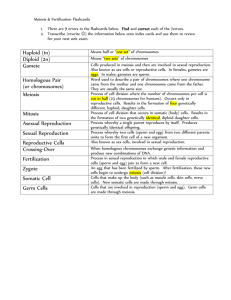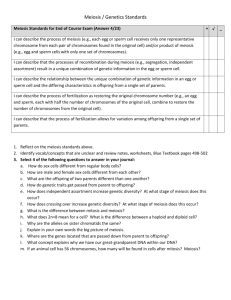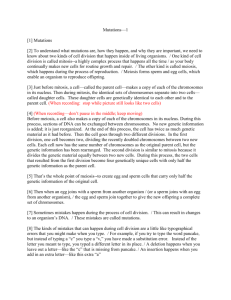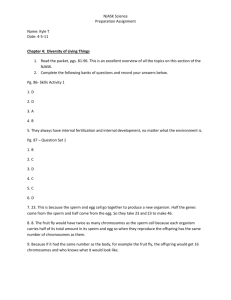KEY Asexual Reproduction Prokaryotes reproduce using the
advertisement
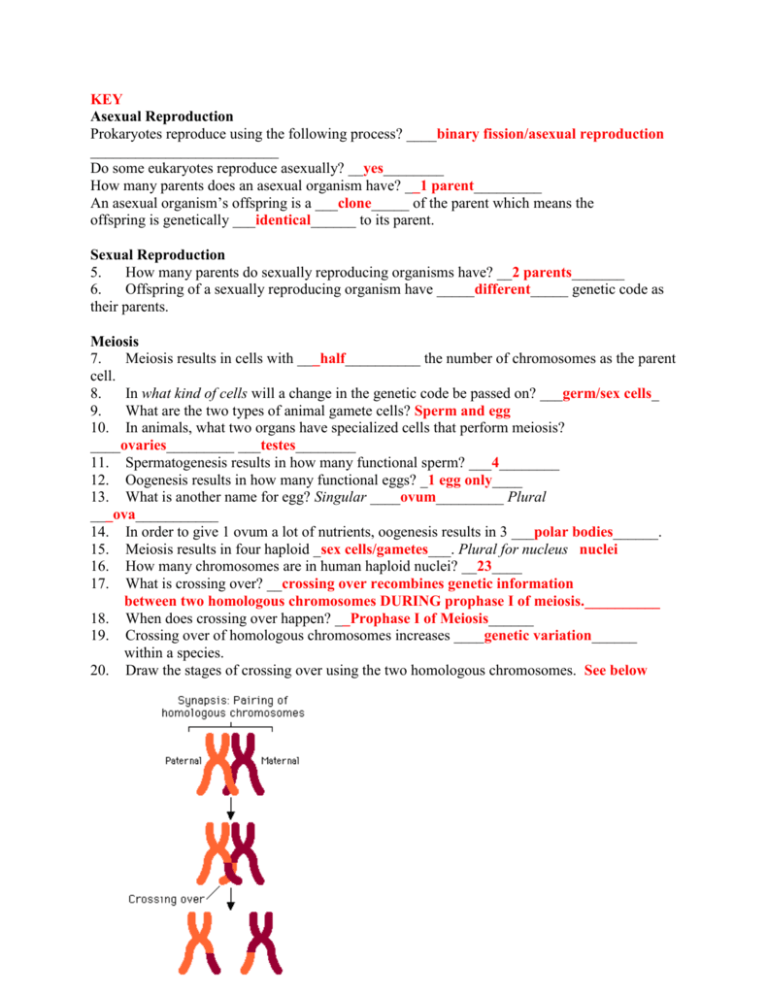
KEY Asexual Reproduction Prokaryotes reproduce using the following process? ____binary fission/asexual reproduction _________________________ Do some eukaryotes reproduce asexually? __yes________ How many parents does an asexual organism have? __1 parent_________ An asexual organism’s offspring is a ___clone_____ of the parent which means the offspring is genetically ___identical______ to its parent. Sexual Reproduction 5. How many parents do sexually reproducing organisms have? __2 parents_______ 6. Offspring of a sexually reproducing organism have _____different_____ genetic code as their parents. Meiosis 7. Meiosis results in cells with ___half__________ the number of chromosomes as the parent cell. 8. In what kind of cells will a change in the genetic code be passed on? ___germ/sex cells_ 9. What are the two types of animal gamete cells? Sperm and egg 10. In animals, what two organs have specialized cells that perform meiosis? ____ovaries_________ ___testes________ 11. Spermatogenesis results in how many functional sperm? ___4________ 12. Oogenesis results in how many functional eggs? _1 egg only____ 13. What is another name for egg? Singular ____ovum_________ Plural ___ova___________ 14. In order to give 1 ovum a lot of nutrients, oogenesis results in 3 ___polar bodies______. 15. Meiosis results in four haploid _sex cells/gametes___. Plural for nucleus nuclei 16. How many chromosomes are in human haploid nuclei? __23____ 17. What is crossing over? __crossing over recombines genetic information between two homologous chromosomes DURING prophase I of meiosis.__________ 18. When does crossing over happen? __Prophase I of Meiosis______ 19. Crossing over of homologous chromosomes increases ____genetic variation______ within a species. 20. Draw the stages of crossing over using the two homologous chromosomes. See below Label the two processes below with sperm, ovum, polar bodies, spermatogenesis, oogenesis, and crossing over. Spermatogenesis Oogenesis Crossing over Sperm (4) Crossing over 1 Ovum^ ^ Polar bodies (3) Fertilization and n Value 22. n equals how many sets of chromosomes? ___1 set_________ 23. 2n equals how many sets of chromosomes? ___2 sets_________ 24. When a sperm fuses with an egg, what is created? ____Zygote_______________ 25. Write in the n value for the following equation. __1n_ sperm + _1n_ egg = _2n_ zygote 26. Why is the fusion of egg and sperm random? _____Because any given sperm with its own genetic combination must find the ovum to fertilize. With millions of sperm at once, this provides many different genetic possibilities_________________ Karyotypes 27. Using the karyotype, circle the gender of this individual and write the gender next to it. Perform nondisjunction by drawing in a 3rd chromosome to create Down syndrome. (extra is at Chromosome 21 “Trisomy 21”) Increasing Genetic Variation 28. What is genetic variation? ___a measure of genetic differences within a population 29. A change in the genetic code is called a __mutation____. 30. ____Fertilization___ is the random fusion of egg and sperm to create unique gene combinations. 31. The exchange of segments by homologous chromosomes is called _crossing over__. 32. The random distribution of chromosomes during meiosis is called _independent assortment (how the chromosomes line up on the equator during metaphase I determines genetic variety)__.


